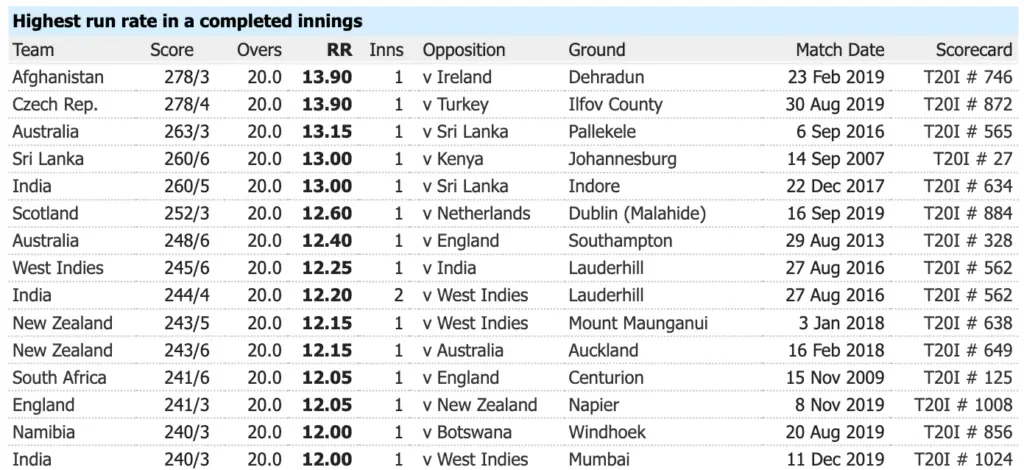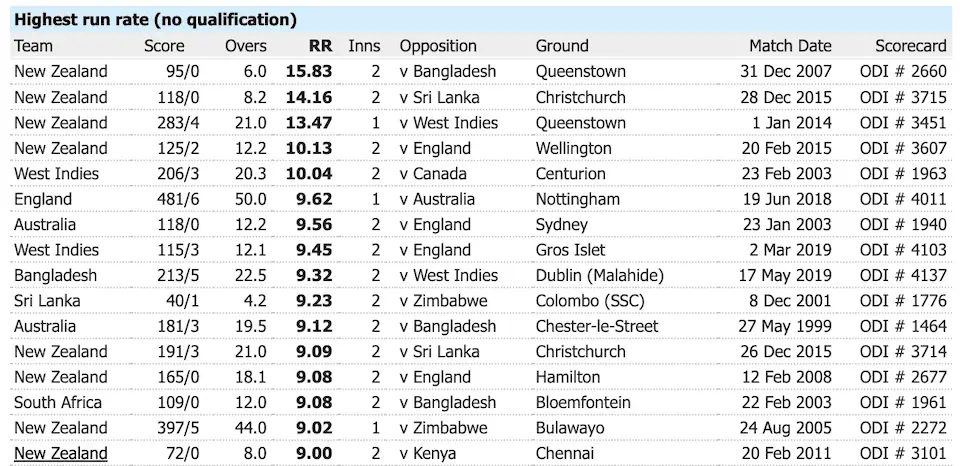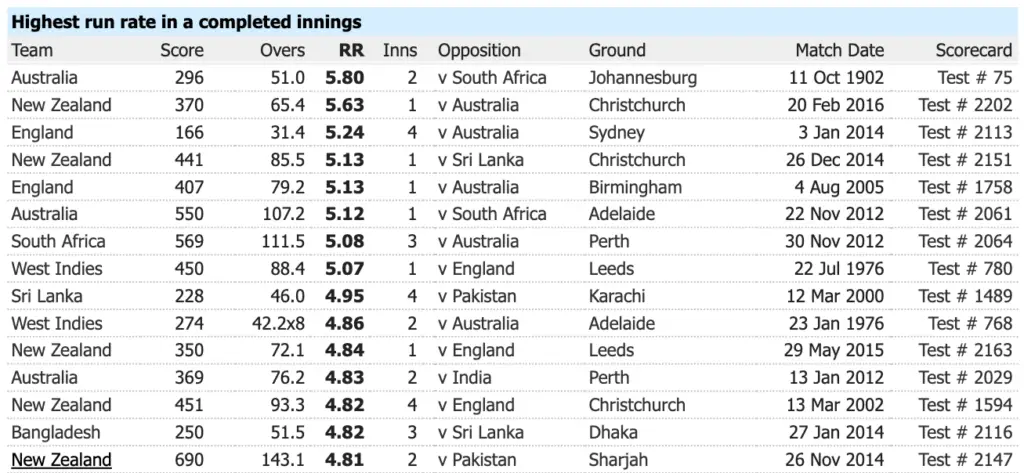Cricket is a game of statistics, and for some “Run Rate” is just another statistic. But, what exactly does this piece of statistic in the game of cricket mean? Is it even important? And, how exactly do we calculate it? In this article, we take a look at the “Run Rate” with a few examples.
So, what is “Run Rate” in Cricket? Run Rate in Cricket is the AVERAGE number of runs scored by a batting team per over (every 6 balls). Run Rate is only an average and DOES NOT mean that a team scores exactly the same number of runs every over.
In other words, Run Rate can be simply defined as the rate at which the runs are scored by a batting team. But, how is it calculated and what is a good run rate in the game of cricket? Let’s learn a bit more about the same –
How is Run Rate Calculated in Cricket? (With Examples)
Run Rate is one of the simplest statistics to calculate in the game of cricket. The formula to calculate the run rate is fairly simple as indicated below –

Let’s understand this with the help of an example.
Example 1 –
Let’s consider One Day match being played between Australia & England. England are batting first and they have managed to score 90 runs in the first 15 overs. So, what should be the run rate for England after 15 overs?
If we look at the formula explained above, it should be fairly easy to calculate the run rate. All we have to do is divide 90 (total number of runs scored) by 15 (total number of overs bowled). Thus,
Run Rate = 90/15 = 6 runs per over (for example 1)
Therefore, after the end of 15 overs, the run rate of England is 6 runs per over. This means, on average, England is scoring 6 runs every 6 balls (1 over = 6 balls) or 1 run every ball.
Again, this is just an average rate at which England, in the above example, is scoring. This doesn’t mean that England manages to score every single ball every time.
Example 2 –
Let’s continue with the same match as mentioned in example 1. England continue to bat and after a few overs, they manage to reach a score of 127 in 24.3 overs. So, what shall be the run rate of England in this example?
Well, we shall follow the same method but with a slight difference to calculate the run rate of England as we did in example 1.
Run Rate = 127 (total number of runs scored) / 24.5 (Total number of overs bowled)
Therefore, Run Rate = 5.18 (I just used a calculator to do the math)
You may, however, be wondering why I changed the 24.3 to 24.5, and the explanation to this is given below –
We need to keep in mind that every over in the game of cricket is made of 6 deliveries. As we mentioned above, run rate is represented as an average runs scored per over or per 6 balls. Thus, 0.3 in 24.3 represents that half the over has actually been bowled even though it is represented as 0.3 instead of 0.5. (I hope this helps you understand).
To make things easier, you can bookmark this page and refer to the following table while calculating the run rate in the middle of the over (instead of when calculating it at the end of the over) –
| No. of Balls | Portion of Over Completed | Decimals |
| 1 | 0.1 (1 out of 6 balls) | 1/6 = 0.17 |
| 2 | 0.2 (2 out of 6 balls) | 2/6 = 0.33 |
| 3 | 0.3 (3 out of 6 balls) | 3/6 = 0.50 |
| 4 | 0.4 (4 out of 6 balls) | 4/6 = 0.67 |
| 5 | 0.5 (5 out of 6 balls) | 5/6 = 0.83 |
What is a Good Run Rate in Cricket?
In a Test Match, a run rate of 3.5 to 4 runs per over is considered a good run rate. Similarly, in an ODI match, an average run rate of about 6 runs per over is often considered a good run rate. For T20 cricket, a run rate of close to 7 or 8 is considered a good run rate.
However, as you may observe from the aforementioned information, there is no single answer to the what is a good run rate.
The run rate in the game of cricket varies based on the format of the game being played. Run rate is usually much higher in a T20 match as compared to a Test Match.
Furthermore, the metric of what is a good run rate has also evolved over the years. About 15-20 years ago, a run rate of about 5 runs per over was considered a good run rate. However, with the onset of T20 cricket, this is not the case anymore.
Another point to consider when understanding a good run rate is the match conditions and the nature of the pitch. If the pitch is dry and slow, the run rate may be much lower. In such a scenario, a run rate of even 5 in an ODI may be considered a match winning one!
What is the Highest Run Rate Achieved in Cricket?
The highest run rate achieved in the game of cricket are different for different formats. We shall take a look at each formats separately.
Please note – there is no particular criteria set for this data. However, the run rate considered is only for matches that have been completed and had an outcome.
For T20 Cricket –

For ODI Matches –

For Test Matches –

All the above mentioned records are for completed matches. For Test Matches, only completed innings has been considered.
What is Economy Rate in Cricket? Is it the Same as Run Rate?
There are various terminologies around the “run rate” that you will come across in the game of cricket. Economy rate is one such terminology that you will come across as often as you shall see the usage of run rate.
As we have learned, the run rate helps to understand the rate at which a batting team has scored the runs. On the other hand, Economy Rate is defined as the number of runs per over conceded by a particular bowler.
While the run rate is a metric to measure the rate of scoring of a team (batting team), the economy rate is a measure of performance of a bowler.
The method to calculate the economy rate is the same as that of the run rate.
Economy Rate = Total number of runs conceded by a bowler / Number of overs bowled by that bowler
What is the difference between Run Rate & Required Run Rate?
Another terminology that you may often come across that is related to the run rate is the “Required Run Rate“.
The required run rate can be defined as the rate at which a team batting in the 2nd innings of a cricket match needs to score the runs in order to achieve the target.
You will most often see the required run rate in the 2nd innings of an ODI or T20 cricket match.
The method to calculate the required run rate is actually in a way a bit in reverse to that of the run rate. The run rate helps you understand the rate at which runs have been scored by a batting team. Whereas, the required run rate helps you understand the rate at which the batting team needs to score in order to reach a target.
The formula to calculate the required run rate is –

Let’s take a look at an example –
In an ODI match of 50 overs between Australia and England, let’s say that England batted first and scored 309 runs in the 50 overs. Now, while batting second, Australia has scored 45 runs in the first 10 overs while chasing a target of 310 runs. So, what would be the required run rate?
Basis the formula stated above, we can easily calculate the required run rate as below –
Required run rate = [310 (target) – 45 (runs already scored)]/40 (total overs remaining as 10 overs have already been bowled)
Thus, required run rate = 265/40 = 6.63
It is also interesting to note that the Run Rate of Australia = 4.5 after 10 overs (45/10).
The required run rate is very helpful for a team batting second to understand how quickly do they need to score in order to win the match. Based on the wickets in hand and the required run rate, a team can choose its strategy of either playing aggressively or playing defensively.
Is Net Run Rate the same as Run Rate?
No. Net run rate is not the same as Run Rate.
Net Run Rate is the method used to identify the team that shall qualify if two or more teams have the same number of points in a league or a tournament.
The method to calculate the Net Run Rate is quite different from that of the run rate. Furthermore, the method of calculating the net run rate may vary from a tournament to another tournament.
Related Questions –
Q. What is the abbreviation of Run Rate in Cricket?
The run rate in cricket is often represented as RR. It is also represented as RPO or Runs Per Over. The meanings of both the abbreviation is the same.
Q. What is the highest possible Run Rate in Cricket?
In theory, the highest run rate possible in cricket is 36. If a team were to score 6 runs every ball (maximum possible), then they shall score 36 runs every over (1 over = 6 balls) and shall end up with a run rate of 36 runs per over.
However, practically, it is next to impossible to score 36 runs every over throughout the match. In fact, 36 runs in an over have been scored less than a handful of times in the history of cricket!
